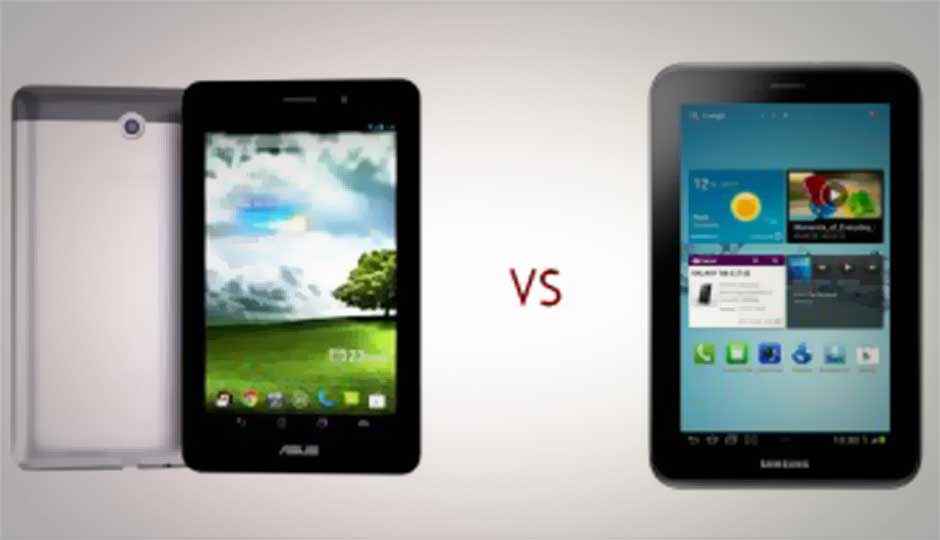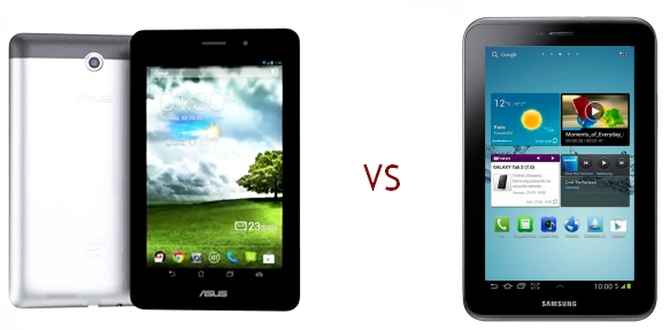Asus FonePad vs. Samsung Galaxy Tab 2: Voice-calling tablets compared
We take a look at how the recently launched Asus FonePad stands up against the Samsung Galaxy Tab 2. Both the tablets boast of 7-inch displays with the ability to make calls.

Asus has launched the FonePad in India for Rs. 15,999. The device is a direct competitor to the Samsung Galaxy Tab 2, which is also priced at Rs. 15,999. The Samsung Galaxy Tab 2 P3100 has been around since July 2012 and is quite a good device.
 Survey
SurveyBoth the Asus FonePad and Samsung Galaxy Tab 2 have 7-inch displays, and boast of the ability to make calls.
We got some hands on time with the Asus FonePad and were quite impressed with what we saw. We reviewed the Galaxy Tab 2 when it launched and were also quite impressed with its performance.
If you are looking to pick up a 7-inch tablet with the ability to make calls, then this comparison is for you.
Specifications
|
Models
|
Asus FonePad
|
Samsung Galaxy Tab 2
|
|
Display Size
|
7-inch
|
7-inch
|
|
Display Type
|
IPS LCD
|
PLS LCD
|
|
Display Resolution (pixels) |
1280×800
|
1024×600
|
|
Weight
|
340 gms
|
345 gms
|
|
Built-in storage
|
8GB
|
16 GB
|
|
Expandable storage
|
up to 32GB via a microSD card
|
up to 32GB via a microSD card
|
|
Chipset
|
Intel Atom Z2420
|
TI OMAP 4430
|
|
Processor
|
1.2GHz single-core with Hyper Threading
|
1GHz dual-core
|
|
RAM
|
1GB
|
1GB
|
|
GPU
|
PowerVR SGX540
|
PowerVR SGX540
|
|
Bluetooth
|
3
|
3
|
|
Rear Camera
|
3.15MP
|
3.15MP
|
|
Front Camera
|
1.2MP
|
VGA
|
|
OS
|
Android 4.1 Jelly Bean
|
Android 4.1 Jelly Bean
|
|
Battery
|
4270mAh
|
4000mAh
|
|
Price
|
Rs. 15,999
|
Rs. 15,999
|
Both the tablets boast of a 7-inch display but the resolution of the FonePad is a bit better. It also has an IPS panel, which means that the viewing angles will be better. This doesn’t mean that the Galaxy Tab 2 is bad by any means. The resolution is a bit low, but consuming content on the Tab 2 was a good experience. The Tab 2 is a tad heavier by 5 grams and this shouldn’t make much of a difference to anyone.
The built-in storage is where the Galaxy Tab 2 is better. For Rs. 15,999 you get 16GB of built-in storage where as the FonePad gives you a mere 8GB. Even though both the tablets offer you the ability to expand the storage with a microSD card, there are some apps that can’t be transferred and it is always better to have more built-in storage wherever possible.
The processor on both the tablets is what will distinguish the performance. Now, we have reviewed the Samsung Galaxy Tab 2 and at the time of its launch it was quite the performer leaving the competition such as the Sony Tablet S and the Motorola Xoom far behind. It has dual-core processor coupled with 1GB of RAM gave it the ability to run all the apps from the Google Play store.
The Asus FonePad on the other hand runs on the Intel Atom Z2420. This chipset may be a bit old, but it is quite impressive nonetheless. When we spent some time with the tablet, it was fluid and good at multitasking. We only managed to play a few games and use the tablet with its basic functionality at the launch event, but what we saw of it, we were quite impressed. We have seen the Intel Atom Z2420 chipset running on the Xolo X500 and we were quite impressed with the synthetic as well as real world performance. How the raw performance translates on a 7-inch display is something we will comment on once we have the tablet with us.
Both the tablets run on Android 4.1 Jelly Bean and will see the 4.2 update. The UI of both the devices is where they differ. The Galaxy Tab 2 has Samsung’s TouchWiz UI, which is one of the better preloaded skins available for Android devices. Apart from the Google Play store, you get access to the Samsung app store. TouchWiz brings with it a slew of nuances that gives you access to apps, shortcuts and widgets on the home screen. The interface is fluid, and to transfer data from your Mac or PC, you need to download the Samsung Kies app.
The Asus FonePad on the other hand has its own UI, which is very similar to the one we have seen on the Padfone. Apart from access to the five customizable home screens, you have access to floating apps. Put simply, these are apps that appear as small windows on the display so you can have a bunch of apps working simultaneously on the screen. You could have the calendar, calculator, web browser and chat window open all at once and shuffle through them without going through the multitasking menu. It is very handy if you need multiple apps open at once.
Both the tablets are quite impressive and we are waiting to get our hands on the Asus FonePad before declaring a winner. If a Jelly Bean tablet with the ability to makes calls and a 7-inch display is your priority, you can consider both the tablets before making your purchase decision.
